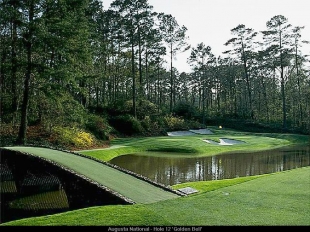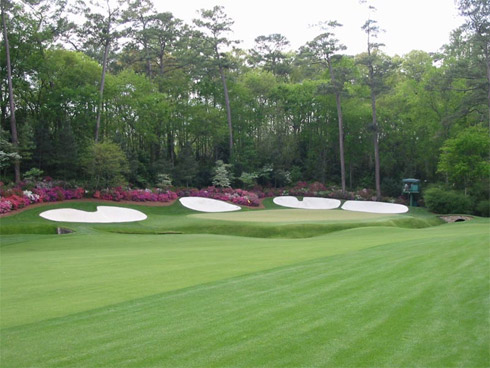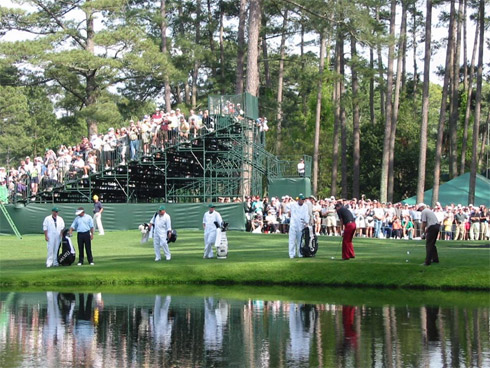 It’s among the most beautiful and exclusive courses in America. Yet everyday golfers feel close to Augusta National because every year we spend a week watching the best players in the world golf their way around a course that 99.9% of us can only ever dream of playing.
It’s among the most beautiful and exclusive courses in America. Yet everyday golfers feel close to Augusta National because every year we spend a week watching the best players in the world golf their way around a course that 99.9% of us can only ever dream of playing.
Still ask any golfer what his or her favorite golf hole in the world is, and many will still point to a hole they’ve never played, and often never even seen other than on TV. They’ll say #12 at Augusta, Firethorn, the last at the Masters, or any of the other 15 beauties at the National. They are holes that are burned into our memories. They connote spring. They make us smile.
 Like most golfers, I have my favorites at Augusta. There’s Golden Bell, the beautiful par three 12th at the apex of Amen Corner. Show a golfer (and many non-golfers) a photo of #12, and they’ll be able to identify it as part of Augusta National. There’s Holly, the thrilling finishing hole; Camellia, a great par four that gets overshadowed due to its proximity to Amen Corner; and Flowering Peach, a drivable par four that still played over par in 2007.
Like most golfers, I have my favorites at Augusta. There’s Golden Bell, the beautiful par three 12th at the apex of Amen Corner. Show a golfer (and many non-golfers) a photo of #12, and they’ll be able to identify it as part of Augusta National. There’s Holly, the thrilling finishing hole; Camellia, a great par four that gets overshadowed due to its proximity to Amen Corner; and Flowering Peach, a drivable par four that still played over par in 2007.
With a group of golf holes as strong as those at Augusta, it’s hard to rank them. But in the Quiet National era, with the course playing so hard throughout, I tend toward those holes that offer the best opportunity for roars, or at least groans. Below are my five favorites. Want to share your favorite? Check out the poll in the forum.
Number Five: Carolina Cherry
Who can forget watching Greg Norman spin his second shot back off the green and all the way down the hill fronting the green in 1996? It was the hole that started his historic collapse, squandering a six-stroke lead he’d taken into the final round.
Augusta National’s ninth is a 460-yard par four that plays to a landing area on the downslope of a hill and then to a green that sits on a hill above. It’s sort of the antithesis of #18, with a right-to-left dogleg instead of to the right, but the hill fronting it is more severe and punishing. Long hitters get an advantage here in that they can cut the corner a little and reach the flat lies at the bottom of the hill. Come up short on this hole and the ball will roll back down the hill, leaving a 35-40 yard pitch.
I like the ninth because it retains some of the “links” style feel that Augusta began with. There’s something cool about that green sitting there on a treeless hill.
Number Four: White Dogwood
The toughest hole on the course is #11, the start of Amen Corner. It’s a 505-yard par four that last year yielded only 15 birdies and inflicted 26 double bogeys or worse.
To crest the hill, players have to hit a 300+-yard drive leaving a delicate mid- to long-iron into a penisula green. In recent years, the hole has been lengthened and a number of trees planted to the right of the fairway. The combo forces players to stay on or near the fairway, and penalizes player severely for missing to the right.
It’s one of the changes to the course that I actually really like. It gives the players two tough shots to execute. I love watching the pros negotiate this hole for the same reasons people watch demolition derbies. Sometimes, carnage can be fun.
Number Three: Pink Dogwood
One of the less seen holes on the course is the 575-yard par-five second. It comes early in the round so there are not always television cameras around, but it is a great hole. Long accurate hitters can fit a drive between the fairway bunker on the right and the trees on the left an get the ball rolling down the hill for extra yardage. From the elevated landing area, some players can still reach the green in two, though the lengthening of the hole in 1999 makes it a three-shot hole for many others. The green is guarded by two bunkers in front, making any shot to the green almost always all carry.
I like this hole in part because we don’t see it all the time though it’s an attractive, strategic hole. It’s where many sub-par rounds get their start.
Number Two: Azalea
 What’s not to love about a hole with 1,300 azaleas in bloom? The 13th hole is a 510-yard par five with a hard left turn that gives players a tough choice on their drives. A player can try to draw a driver, but risks running it through the fairway, or he can take a three-wood and turn it around the corner, leaving a wood or long- to mid-iron into a green protected by a creek. Shots on the right side of the fairway will put the ball above the feet for right-handers making going for it a risky proposition.
What’s not to love about a hole with 1,300 azaleas in bloom? The 13th hole is a 510-yard par five with a hard left turn that gives players a tough choice on their drives. A player can try to draw a driver, but risks running it through the fairway, or he can take a three-wood and turn it around the corner, leaving a wood or long- to mid-iron into a green protected by a creek. Shots on the right side of the fairway will put the ball above the feet for right-handers making going for it a risky proposition.
I love Azalea because gives players a chance to score. It’s one of the few holes left at Augusta that plays under par. It’s a great strategic hole without being a long hole.
Number One: Redbud
A signature hole on virtually any other course in the world, #16 still doesn’t quite have the runway model good looks of its fellow back-nine par three, #12. The 170-yarder plays quite difficult despite some good pin positions that are fed the ball by slopes on the green. Still #16 seems to be the stage for some sort of drama year in and year out. This is the scene of Tiger Woods’ chip-in in 2005 and Jack Nicklaus’ near ace in 1986.
There are better chances for birdie at #17 and #18, but Redbud is always a great hole to watch. The way putts and chips roll off the slopes of the green adds exquisitely to the suspense of a final round.

Plus, the 16th is home to the Augusta National Water Skipping Contest that takes place during the practice rounds. Most players take moment to please the crowd by hitting a golf ball so it skips across the pond and runs up on the green. I love the juxtaposition if this kind of silly tradition against the pomp that is the Masters. It’s part of what makes this championship so much fun to watch.
Photo Credits: © Everett, About Golf.

I like hole number 13 because it’s the first chance for players to make a move on the back nine. There is a great potential for change. If a player is reeling from a mistake on number 12, they have a chance to jump-start their round. If a player has been stalling with pars (E.g., Tiger Woods yesterday.) then it’s a chance to get going.
Plus, I like par fives that offer an eagle chance. Hole 15 is good, too, but doesn’t have the same visual appeal as Hole 13.
For me it’s number 13. The picture you have here says it all. So beautiful, you hate to tear up the turf in the fairway with a divot.
Hole 13 for me too…almost liked it better when it was shorter so more guys went for it in 2.